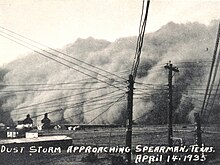



Black Sunday is a particularly severe dust storm that occurred on April 14, 1935, as part of the Dust Bowl in the United States.[1] It was one of the worst dust storms in American history and caused immense economic and agricultural damage.[2] It is estimated that 300 thousand tons of topsoil were displaced from the prairie area.[3]
On the afternoon of April 14, residents of several plains states were forced to take cover as a dust storm or "black blizzard" blew through the region. The storm first hit the Oklahoma panhandle and northwestern Oklahoma and moved south for the day.[1] It hit Beaver, Oklahoma around 4 p.m., Boise City around 5:15, and Amarillo, Texas, at 7:20.[1] The conditions were the most severe in the Oklahoma and Texas panhandles, but the storm's effects were also felt in surrounding areas.[1] Drought, erosion, bare soil, and winds caused the dust to fly freely and at high speeds.[4]
- ^ a b c d "The Black Sunday Dust Storm of 14 April 1935". National Weather Service: Norman, Oklahoma Weather Forecast Office. Retrieved 23 May 2012.
- ^ "Black Sunday: April 14, 1935". PBS. Archived from the original on 20 April 2012. Retrieved 24 May 2012.
- ^ Black Blizzard, History Channel documentary.
- ^ "The Dust Bowl Drought". Drought: A Paleo Perspective – 20th Century Drought. Retrieved 24 May 2012.